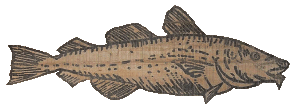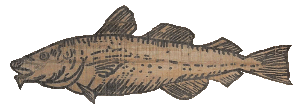


Getting things started for a fish business like Shute & Merchant required more than just a plan and public announcements. Financially, a fairly substantial investment was needed to get started, and to keep things going.
A stereoview from the 1870s shows how the Shute & Merchant facilities had grown since the image depicted in the Kilby Webb Elwell painting done several years earlier. By that time, the firm had added a smokehouse, as this was the newest way to preserve fish. The addition of the smokehouse increased the range of products Shute & Merchant could market.
According to news items published in the Gloucester paper on May 8 and May 15, 1878, finances had become an issue for this firm. Creditors of Shute & Merchant gathered to discuss those concerns. At this time the company's debt was $67,000 and nominal assets were $52,000. A committee of three men was appointed to investigate things and to make a report. The following week that committee returned with its report, and the decision was a compromise of 20% cash, 10 % paid in four months and 10% paid in eight months via unindorsed notes of the firm. Clearly, Shute & Merchant made good on this repayment, and continued as a successful business for a number of decades after that incident.

An earlier Procter Brothers stereoview looking across the inner harbor from Friend Street captured the Shute & Merchant wharves and buildings off in the distance. When compared with the images above and below, one can see that during the time between the taking of the two views, Shute & Merchant double the size of their smoke house. That increase from 5 to 10 compartments probably resulted from a significant increase in the desire for smoked fish products being sold by the firm.

The Shute & Merchant smokehouse image was included in the 1892 U.S. Bulletin of the US Fisheries -- pg 498-499.
In that publication, their smokehouse is described as follows: The principal smokehouse at Gloucester consists of a series of 10 compartments side by side, and 6 feet wide, 14 feet long, and about 20 feet high. The flooring is of a lattice-work, under which is a vault about 6 feet deep for generating the smoke. Within each compartment is a lane or passageway extending the length of the room, on each side of which are arranged 3 sets of parallel bars, one end of each set resting on upright poles forming the side of the lane and the other resting against the wall of the compartment. The first set of parallel bars is 4 feet from the lattice floor, the second 3 feet above the first, and the third 3 feet above the second and an equal distance below the roof. Upon these bars are placed the ends of the sticks, which hold the halibut. Each stick will carry fro 5 to 7 fletches (a large boneless fillet of halibut) and about 20 sticks will rest on each pair of parallel bars. The capacity of each of the 10 compartments is about 120 sticks, or 600 to 800 fletches, equivalent to about 3,000 pounds of smoked halibut. (The Shute & Merchant smoke house had 10 compartments, and since the photograph of theirs was used in this Bulletin, it seems likely that this is the one they are describing.)
Smoking usually takes about 2 - 5 days, but if the weather is damp, moisture collects on the fish and the process may take up to 7 days. During the winter it is possible to keep the fires hotter, so the smoking can be completed in a shorter amount of time. If the fires get too hot, the fletches can become too soft and this may cause them to fall off the sticks and drop to the floor.